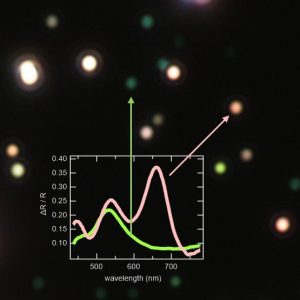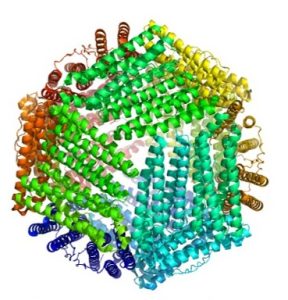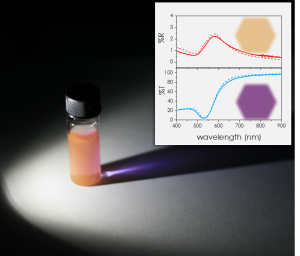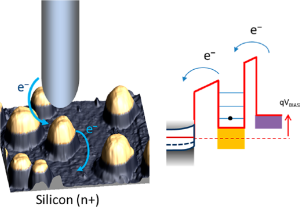back to my home page (ENG) || Retour à ma page d’accueil (FR)
My current research topics
Last updated 10-Dec-2023
(1) Characterization and control of the electronic properties at the scale of a single nanoparticle
Gold nanoparticles can be viewed as extra-small electrodes and help understand how electronic currents can be controlled at the smallest scale at complex interfaces.
The unrivalled advantage of gold over any other metals is to remain metallic at the nanoscale, without being modified by oxidation. We are currently investigating how the work function of gold is modified at the nanoscale, how the electric charging of single nanoparticle is controlled by its chemical functionalization. For example, the number of charges stored by individual nanoparticles was measured in air with KPFM (Kelvin Probe Force Microscopy). Our group has purchased two state-of-the-art KPFM (2015 and 2019). Currently we investigate how the nature of molecules capping gold nanoparticles modifies their electrical properties (work function, charge state).
(2) Charge transport at the molecule-nanoparticle interface: Coulomb blockade and fundamental mechanism of conduction
Gold nanoparticles serve as ultra-small electron dispensers and make possible the control of electric current with the accuracy of a single electron (Coulomb blockade). The challenge is to fabricate reproducible architectures where gold nanoparticles of diameters between 5 and 10 nm are deposited on top of a GOM molecular layer which plays the role of an insulating layer (tunnel barrier) and which is grafted on a silicon substrate. The experimental study is carried out in ultra-high vacuum with an STM (Scanning Tunnel Microscope).
(3) Plasmonics and optical properties of nanoparticles linked to their electronic properties

ANR project PlasmoChrom: collaborative research with Elke Scheer and Thomas Huhn, Germany
Gold nanoparticles exhibit unique optical properties related to their plasmon resonance (LSPR). LSPR under excitation by light, induces a strong resonance of the electrons inside the nanoparticles. We seek using this high-energy electrons (called hot electrons) for enhancing conductive properties of conjugated molecules. We are working in particular with switchable molecules such as diarylethene (Nobel Prize in chemistry 2016) whose morphology and electronic properties can be switched by illumination at the proper wavelength. These molecules can be switched from conductive to insulating molecular wire. The PlasmoChrom project is based on the expertise in three hot topics shared by the three partners of the project : the understanding of electrical transport through metal-molecule-metal junctions, the synthesis of tailored switching molecules, and advanced plasmonics related to the physics of photo-assisted transport.
(4) Functionalization of silicon surfaces with electrically active chemical species
Molecules are self-assembled into monolayers on silicon surfaces with an extreme control so that we can avoid any oxidation of silicon, even at room pressure. We have especially studied the case of Grafted Organic Monolayers (GOM) on oxide-free silicon and have developed a chemistry to graft gold nanoparticles or POM (polyoxometallate). This last aspect is a collaboration with Pr. A. Proust (Sorbonne Université). POM such as PMO12O40, with M = W(+VI) or Mo(+VI) are investigated. These POMs can be oxidized or reduced without any geometrical change. In other words, they can store charges at an extremely high density without any changes and have huge application in molecular electronics.
(5) Biomolecular electronics, based on ferritin nanocage
Collaboration with Assoc. Prof. Sierin Lim (Nanyang Technical University, Singapore).
Ferritin nanocages used as programmable bricks for biomolecular electronics

Biomolecular electronics is the development of a reliable approach for integrating proteins and peptides into electrical circuits. It takes advantage of the Nature’s structuring processes that are robust and precise with the goal of achieving reproducible and reliable electronic operations.
Ferritin is a protein known as the main iron cellular storage molecule in the human body (see Figure). It is also an attractive candidate to be incorporated into electrical junctions because of its unique architecture made of a protein shell with an iron core. Moreover, ferritin can be “engineered” so that it carries either positive or negative charges. By assembling a monolayer with these charge-controlled ferritins on the top of a Field-Effect Transistor architecture, it is possible to control the amount of electrical current flowing through the device. This transistor is “gated” by a programmable proteins layer. The goal of the present project is to develop this prototype device and demonstrate that such a biochemical monolayer gives rise to new architectures for innovative electronic devices or advanced sensors.
(6) Plasmonic color engineering (see start-up Bichromatics).

Gold joins nanotechnology for creating new visual effects in materials. Transparent materials become bichromatic, with two very different colors depending on whether the material is observed in transparency or in reflection. This is the BICHROMATICS process.


